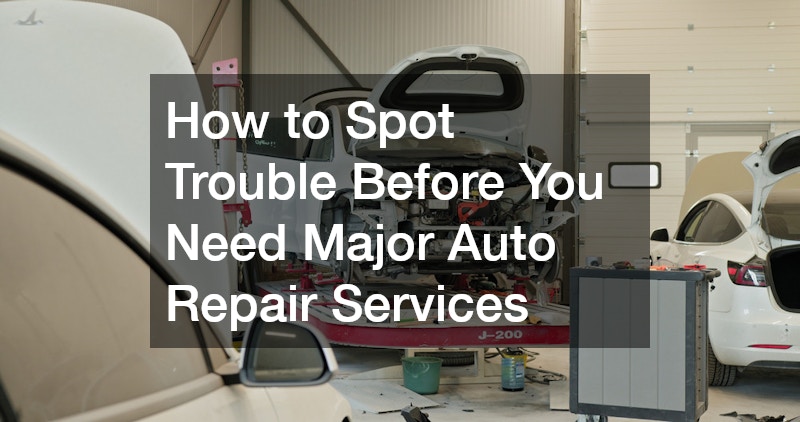This article aims to educate car owners on identifying early signs of automotive issues to prevent costly major repairs. Understanding these warning signs can save you time and money while ensuring your vehicle remains safe and efficient. Proactive car maintenance not only extends the lifespan of your vehicle but also enhances its performance, contributing to a seamless driving experience.
How Unusual Noises Indicate a Problem
Identifying Common Engine Noises
Unusual engine noises are often the first indicators of potential problems within your vehicle. It’s crucial to familiarize yourself with sounds like knocking, pinging, or tapping, as they can point to issues like engine knocking, which arises from improper combustion of the fuel-air mixture.
Addressing these sounds early can prevent further damage and expensive repairs, keeping your car running smoothly.
Such noises can signal various underlying issues; for instance, knocking might indicate a problem with the spark plugs or timing, while squealing may suggest a loose or worn-out belt. Regularly tuning into the typical sounds of your engine can make it easier to notice when something is amiss. This awareness allows you to take prompt action, potentially saving you significant sums in repair costs.
When to Consult a Mechanic
Determining when to consult a mechanic for unusual engine noises largely depends on the persistence and intensity of the sound. If a noise persists over several trips or noticeably worsens, it’s wise to seek a professional opinion. Mechanics have specialized tools and experience that can pinpoint issues that might not be apparent to the untrained ear.
Ignoring persistent sounds increases the risk of exacerbating the problem, potentially leading to more severe damage. Repetitive or intensifying noises might mean critical components are failing, necessitating immediate attention to prevent breakdowns. Regular check-ups and addressing noises early can prevent extensive repairs down the road, safeguarding your investment in your vehicle.
The Visual Signs of Automotive Trouble
Inspecting for Leaks and Fluid Levels
Regular inspection of your vehicle’s exterior can help visually identify potential automotive issues like leaks or abnormal fluid levels. Puddles or stains under your car can indicate leaks in critical systems such as coolant, oil, or brake fluid. Monitoring these elements can prevent engine overheating, lubrication failure, and braking issues, maintaining your car’s health.
Understanding the color and smell of different automotive fluids can help you diagnose a problem. For instance, a bright green puddle typically suggests a coolant leak, while a reddish fluid could point to a transmission issue. Familiarity with this knowledge equips you to take necessary preventive actions swiftly, protecting your vehicle from severe damage.
Tire and Brake Wear Indicators
Examining your tires and brakes frequently can show early signs of wear that might affect vehicle safety and handling. Tread depth must be adequate to maintain traction, particularly in adverse weather conditions, while uneven wear can indicate alignment or suspension issues. Simple tools like a tread depth gauge can provide vital information about tire condition, allowing you to address alignment problems promptly.
Brake systems should also not be overlooked, as they are critical to vehicle safety. Listening for squealing noises when braking, checking for visible wear on brake pads, and ensuring brake fluid levels are crucial steps in identifying potential issues. Regular inspection helps maintain optimal braking performance, preventing accidents and ensuring a safe driving experience.
How Strange Smells Signal Automotive Issues
Identifying Common Automotive Odors
Unusual smells emanating from your vehicle can serve as warning signals of mechanical problems. A burning rubber odor could indicate issues with the serpentine belt or a misaligned accessory drive component. Similarly, a sweet syrup scent might suggest a coolant leak, while a rotten egg smell could signify a problem with the catalytic converter.
Understanding these odor signals allows you to act swiftly to mitigate potential damage. Ignoring these smells can lead to engine overheating, steering problems, or even exhaust leaks, posing health risks. By identifying and addressing strange odors promptly, you minimize the risk of serious engine or exhaust system failures.
Immediate Actions to Take
When you detect unusual smells, it’s important to prepare to take immediate action to prevent further complications. Park your car in a safe location and investigate the possible source of the smell carefully. This initial step not only ensures your safety but also prevents exacerbating any possible issues with your vehicle.
In instances of burning rubber smell, immediately check the tires and belts to ensure there are no visible signs of damage or contact with hot surfaces. If the smell persists without an obvious source, a visit to the mechanic for a professional evaluation is necessary. Communicating the specifics of the odor can facilitate accurate troubleshooting, thereby saving time in diagnosis.
Regular monitoring of your car’s auditory, visual, and olfactory signals can help detect potential problems early, reducing the need for major auto repair services. By maintaining vigilance and understanding these warning signs, you can ensure a smoother and more efficient driving experience. Proactive care and timely interventions are the key to keeping your vehicle in optimal condition, ultimately saving money and ensuring safety on the road.

